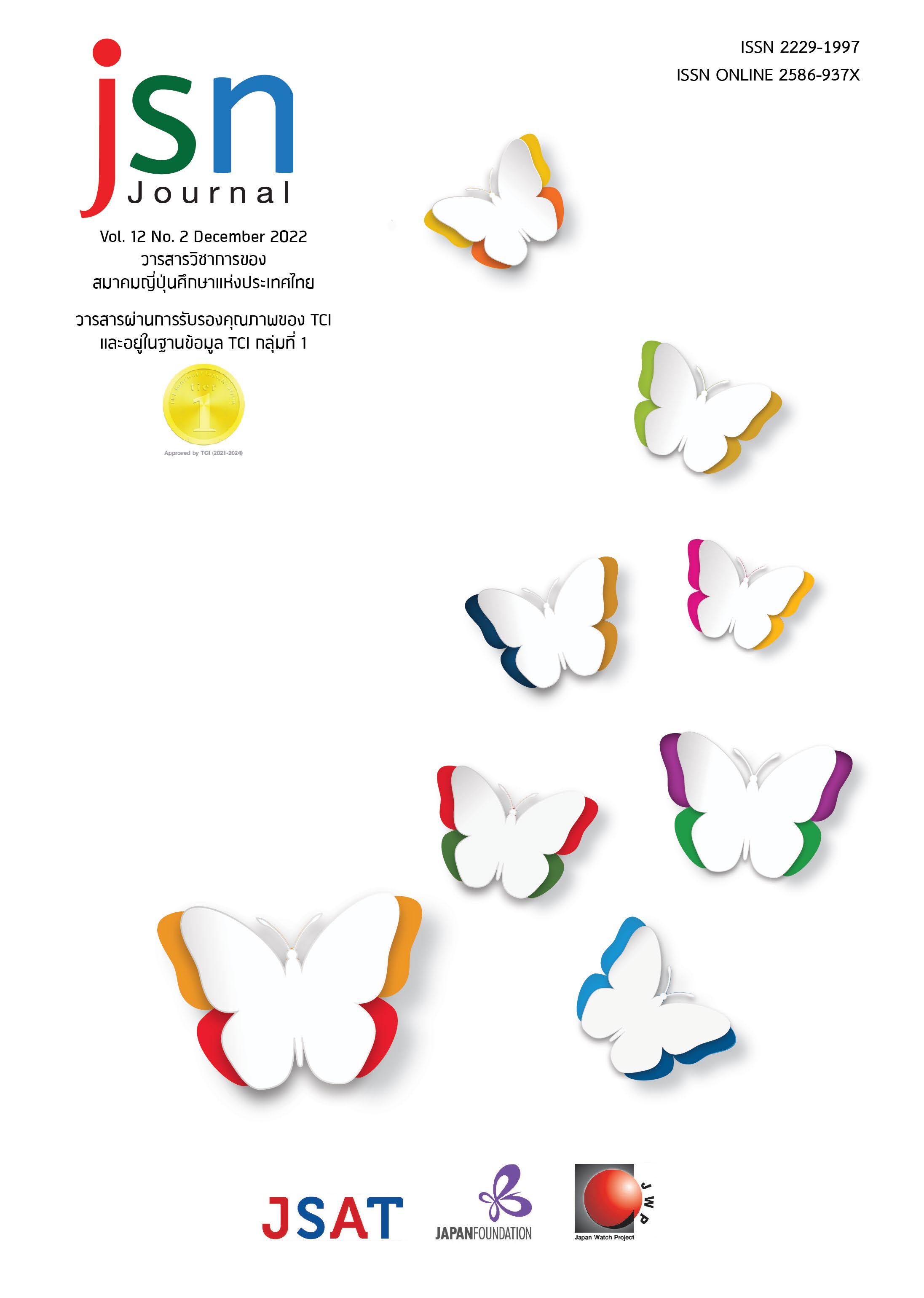A Comparative Analysis and the Development of the Learning Style of Japanese Four-character Idiomatic Compounds and Thai Four-part Elaborate Expressions
Main Article Content
Abstract
The purpose of this research was to conduct a comparative analysis of Japanese four-character idiomatic compounds and Thai four-part elaborate expressions; to determine the structure, meaning, and worldviews that emerge from idioms; and to develop a learning pattern for Japanese four-character compounds through online lessons and to study the results of using online lessons. This research is applied research. The methodology of document analysis and quasi-experimental research was applied. Specific sampling: collect and synthesize both quantitative and qualitative data. After that, the research results obtained were applied to developing online lessons. Further, the effects of using the online lessons generated from pre- and post-study achievement were studied. The data was analyzed using percentage, mean, and standard deviation statistics by using the t-test dependent formula. The results showed that the structure of idioms distinguishes similarities and differences into three groups: (1) the group in which the four kanji are all different and the four words are all different; (2) the group where one of the kanji is duplicated and one word is the same; and (3) the groups with one of the opposite kanji characters and have one word opposite each other. However, the structure of Japanese four-character idiomatic compounds in terms of the Thai four-part elaborate expressions with more than four words or four syllables and divided into two paragraphs was not found. The semantic relationship between the four kanji and the four words in the idiom can be divided into three groups: (1) the four kanji have a corresponding meaning, and the four words have the same meaning. (2) kanji with opposite meanings and words with opposite meanings; and (3) kanji with the same and opposite meanings and words with both the same and opposite meanings. The worldviews reflected in idioms have both similarities and differences; namely, the worldview of a person's characteristics; worldviews about the emotions that arise in the mind; worldviews about life; worldviews regarding the arts and faith; worldviews about society and communication; and worldviews about time, nature, and various changing conditions. The developed online lesson of Japanese four-character idiomatic compounds is of a good quality. The learning achievement of the sample that studied through the online lessons after learning was higher than before, statistically significant at the 0.05 level.
Article Details

This work is licensed under a Creative Commons Attribution-NonCommercial-NoDerivatives 4.0 International License.
ข้อความและข้อคิดเห็นต่างๆ ในบทความเป็นของผู้เขียนบทความนั้นๆ ไม่ใช่ความเห็นของกองบรรณาธิการหรือของวารสาร jsn Journal
References
กาญจนา นาคสกุล. (2558). คำสี่จังหวะ. เล่ม 1. กรุงเทพฯ : สมาคมครูภาษาไทยแห่งประเทศไทย.
กรมวิชาการ. (2543). หนังสืออ้างอิงระดับมัธยมศึกษา “สํานวนไทย”. กรุงเทพฯ : ศูนย์หนังสือกรมวิชาการ กระทรวงศึกษาธิการ.
ขุนวิจิตรมาตรา(สง่า กาญจนาคพันธุ์). (2541). สำนวนไทย. พิมพ์ครั้งที่ 4. กรุงเทพฯ: สมาคมส่งเสริมเทคโนโลยี(ไทย-ญี่ปุ่น).
นภสินธุ์ แผลงศร. (2557). โยะจิจุกุโงะ สำนวนคันจิประสม 4 ตัวอักษรภาษาญี่ปุ่น. กรุงเทพฯ: สำนักพิมพ์แห่งจุฬาลงกรณ์มหาวิทยาลัย.
พิจิตรา ธงพานิช. (2562). วิชาการจัดการเรียนรู้และการจัดการในชั้นเรียน:รูปแบบการสอน ADDIE (ADDIE Model) [เว็บบล็อก]. จาก http://adi2learn.blogspot.com/2018/01/addie-model.html
ราชบัณฑิตยสถาน. (2543). ภาษิต คำพังเพย สำนวนไทย ฉบับราชบัณฑิตยสถาน. กรุงเทพฯ : ราชบัณฑิตยสถาน.
ราชบัณฑิตยสถาน. (2554). พจนานุกรมฉบับราชบัณฑิตยสถาน. กรุงเทพฯ : ราชบัณฑิตยสถาน.
สุจิตรา จำนงอุดม. (2556). การใช้คำซ้อนสี่หน่วยในวัจนลีลา. วารสารธรรมศาสตร์. ปีที่ 32 ฉบับที่ 1 มกราคม-เมษายน 2556.
สุดารัตน์ จงบูรณสิทธิ์. (2562). การใช้รูปแบบการสอน ADDIE Model เพื่อการปรับปรุงและพัฒนาการเรียนการสอนภาษาจีนให้สอดคล้องกับศตวรรษที่ 21. การประชุมวิชาการด้านมนุษยศาสตร์และสังคมศาสตร์ระดับชาติครั้งที่ 2 หน้า 667-679.
สำนักงานราชบัณฑิตยสถาน. (2564). โลกทัศน์ (๑๐ กรกฎาคม ๒๕๕๐) [เว็บบล็อก]. จาก http://legacy.orst.go.th/?knowledges
อมรา ประสิทธิ์รัฐสินธุ์. (2553). ชนิดของคำในภาษาไทย: การวิเคราะห์ทางวากยสัมพันธ์. กรุงเทพฯ : สำนักพิมพ์เอเอ็สพี.
竹田 晃(1998)『四字熟語・成句辞典』 [第九版] 講談社
日本漢字教育振興会(2012)『漢検 四字熟語辞典』日本漢字能力検定協会
三省堂編修所(2013)『新明解 四字熟語辞典』第二版 三省堂
田近洵一・近藤 章 編(2015)『例解小学四字熟語辞典 新袋版ワイド版』三省堂


